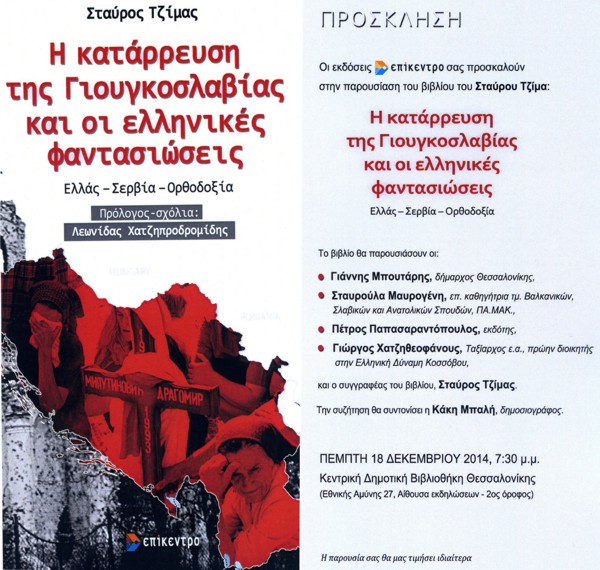Title photo: vojaskimuzej.si
Anastasia Balezdrova
"The book is the product of 25 years of work in a region that, at the time, generated major events, which shook the entire world. From that perspective, I think I am very happy that I was able to experience it all.
Readers will see that this is not a book streaming with blood. I tried to avoid descriptions that would horrify readers. My goal is to explain, with testimonies of ordinary citizens and interviews with leaders who played a leading role in the tragic events, what happened in Yugoslavia and how and why it happened.
My book is not a doctoral thesis about the crisis in Yugoslavia. This is a historians’ job. I wrote about things I saw, heard and learned."
 This is how journalist Stavros Tzimas describes his book "The breakup of Yugoslavia and the Greek illusions" for GRReporter. As a correspondent and director of the Thessaloniki office of the Greek daily Kathimerini, he followed very closely the events that had marked the history of the region over the past quarter of a century.
This is how journalist Stavros Tzimas describes his book "The breakup of Yugoslavia and the Greek illusions" for GRReporter. As a correspondent and director of the Thessaloniki office of the Greek daily Kathimerini, he followed very closely the events that had marked the history of the region over the past quarter of a century.
Tito's death
The book begins with my meeting with a nurse in Ljubljana. She is the woman who closed Tito’s eyes when he died. The story begins from the moment of his death that marks the beginning of the end of Yugoslavia. I have included a description of his funeral, which was the biggest organized funeral until then and which became an international event.
Then immediately I turn to the events of 1991, when the breakup of Yugoslavia began due to the lack of the hand that had held the whole system. Tito was gone, the other pole, namely the army, began to shake and the Yugoslav Communist Party was almost disbanded.
In March 1991, there was a meeting of the Presidency of the Socialist Federal Republic of Yugoslavia and the main topic of discussion was the adoption of a decision to organize a military coup in order to save the federation. The participants failed to agree, which marked the beginning of the first clashes.
The breakup of Yugoslavia
I describe how each of the republics began working for its own cause, presenting to the readers many developments behind the scenes. There are interviews with Stipe Mesic, who was a representative of Croatia in the presidency of the Socialist Federal Republic of Yugoslavia, and then its President, with President of Slovenia Milan Kucan, President of Serbia Borislav Jovic, with Vasil Tupurkovski of the Former Yugoslav Republic of Macedonia (FYROM). They present in great detail all the events that happened during this period.
Another scene presented in the book is how Slobodan Milosevic and Franjo Tudjman divided Bosnia between themselves while eating deer meat and drinking wine in the Karadjordjevo resort. This is also presented with the help of stories and testimonies of people who played a leading role in the events.
The creation of the Former Yugoslav Republic of Macedonia
At a secret meeting held in a government residence in Ohrid, involving Milosevic, Gligorov and Tupurkovski, the spirits had aroused. Afterwards, Milosevic turned to the others with the words, "Good luck, brothers! We will always be united by history and our common enemy, which is Albanians." In this part of the book, I have included an interview with Konstantinos Mitsotakis, which he has recently given me. In it, he tells how Milosevic had offered him the armies of Greece and Serbia to invade FYROM and divide its territory. Furthermore, he had promised to help Greece resolve the dispute with the country's name, but Mitsotakis had refused.

The war in Kosovo and the role of Bulgaria within its context
One of the main topics in the description of the war in Kosovo is the probability of the war transferring to FYROM, then to Greece and of Bulgaria intervening afterwards. I have included a statement of former Bulgarian President Petar Stoyanov, according to which Bulgaria was ready to send forces to Macedonia in order to protect its borders with Kosovo and to prevent the spread of the war there. This statement had a resounding response, as the probable military intervention of Bulgaria would automatically mean the interference of Greece, then subsequently of Turkey, and the Balkans would have been in flames once again. However, the Bulgarian president withdrew the statement and things calmed down.
Another Bulgarian connection with the war in Kosovo is the so-called Horseshoe plan. Years later, Foreign Minister of Bulgaria at the time Nadezhda Mihailova said that during Milosevic's purge against ethnic Albanians in Kosovo the Bulgarian intelligence had submitted to her a copy of the Horseshoe plan, which was presented as the plan of Milosevic for the expulsion of Albanians from Kosovo. Mihailova said that she had immediately submitted the document to her German counterpart Joschka Fischer. Whether the document was authentic or not remains a mystery to this day but at that time, it played the role of a very good argument in favour of the intervention of NATO forces in Kosovo.
Further on in the book, I present the war in FYROM and interviews with Kiro Gligorov, Ali Ahmeti, Boris Trajkovski and Ibrahim Rugova.